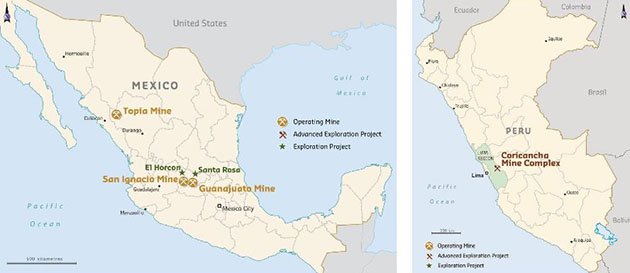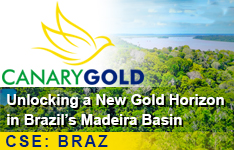The Gold Report: Great Panther Silver Limited (GPR:TSX; GPL:NYSE.MKT) just completed the acquisition of the Coricancha polymetallic mine in Peru from Nyrstar NV (NYR:BSE). It's the company's first venture outside of Mexico. Would you tell us more about the property?
Robert Archer: We've been working toward acquiring something like this in Peru for about seven years. We've been involved in a few different potential transactions over that period, none of which we were able to finalize. But I'm pleased to say that we have concluded the Coricancha acquisition.
The Coricancha project is on care and maintenance. It is a mine that had been operating up until 2013, so it has a fully functional and permitted plant, 600 tons per day (600 tpd). It's an underground, narrow vein, polymetallic deposit, very much like the type of mine that we operate in Mexico. In fact, it's midway in size between our Topia and Guanajuato mines in Mexico. So, it's something that we're very comfortable with from an operational standpoint and fits very well with our portfolio. From a production standpoint, we know from historical records that if we can get it back up and running at full capacity at 600 tpd, then it should produce about 3 million ounces (3 Moz) silver equivalent on annual basis, which would be about a 75% increase for the company. So it's pretty significant in that regard.
TGR: Why did you focus on Peru?
RA: I went there about eight years ago and recognized that, for one thing, there were very few public companies our size working in Peru. There were a number of large, multinational companies and a number of small, family-owned mines operating along the coast, but very few midsized operations. And geologically and statistically there have to be a number of midsized deposits, so there seemed to be a really good opportunity there.
It was clear that we would have to be well established in Peru to be able to take advantage of that because most of these midsized deposits are owned by either families or private Peruvian companies. So, we really had to get ourselves established there, build out our network and then hopefully acquire something like we've done now with Coricancha to basically build a foundation from which to continue to build and expand in the country. It was that opportunity that really struck me.
TGR: Great Panther completed the acquisition on June 30 and now owns 100% of Coricancha. What are the terms of the arrangement?
RA: It's a very good deal for us. It's a risk-sharing deal structure whereby we don't have to put up very much upfront. We only pay $100,000 ($100K) to Nyrstar. There are just a few minor items that were conditional on the closing that have to be completed, and then we'll make that payment. Beyond that, we don't have to make any further payments until after the mine is in production, we've paid back all of our investment to get it to that point and the mine is cash flow positive. At that point, we'll pay Nyrstar 15% of the cash flow over a five-year period up to a maximum of $10 million ($10M). If the project's successful, we both win. If it's not successful for any reason at all, then we haven't just lined Nyrstar's pockets while we're left with the liability.
TGR: What are your next steps at Coricancha?
RA: We had the project under option for a year during 2015–2016 and we did some diamond drilling and some environmental and engineering studies. Essentially, we'll be continuing with all of those and rolling all of that into a prefeasibility study this year, which we hope to have completed by Q1/18.
At the same time, we have already started to update a mineral resource estimate. The last one was done in 2012, so it has to be considered historical; it was not done to NI 43-101 standards. The new one will be NI-43-101-compliant, and it will incorporate a large database of underground sampling that was not previously part of the resource. That will give us a greater degree of confidence in the numbers.
We also recognize that the previous resource was done at higher metal prices, i.e., silver at $22/ounce, gold at $1,300/ounce. It is quite likely that the new compliant resource will be smaller in terms of contained ounces than the previous one, but we will have more confidence in the numbers. And as metal prices increase, of course, the resource can be updated and expanded accordingly.
TGR: Why did Nyrstar have Coricancha on care and maintenance? What can you do that Nyrstar couldn't to make it an economic asset?
RA: First off, it's important to recognize that a mine like Coricancha is not well suited to a large company like Nyrstar. Nyrstar was not previously a mining company. It was a large smelting and trading company that decided around 2008 to get into the mining business and try to be a fully integrated company, from mining the raw materials right up through processing them and selling the final metals, much like Glencore International Plc (GLEN:LSE). But it was never really very successful with the mining aspect of that. Given that it's primarily a zinc producer, I'm not really sure why it bought Coricancha in the first place because zinc is only about 15% of the revenue from the mine. The rest of it is gold, silver, copper and lead.
Being that it's a narrow vein, underground operation, Nyrstar never really managed to get it to the point where it was operating efficiently and economically. When metal prices dropped in 2013, Nyrstar decided to put the mine on care and maintenance. It did that at a few of its operations. Then ultimately, in late 2015 or early 2016, Nyrstar decided to get out of the mining business altogether and sell all of its mining operations worldwide. That provided us an opportunity to renegotiate the outright purchase of the mine.
TGR: You said that you see the potential for Coricancha to increase Great Panther's production by 75%. Could you talk about the scale of it compared to your current mines in Mexico—Guanajuato, San Ignacio and Topia?
RA: In terms of tonnage, it's more or less in between. Topia is running at around 250 tpd. The Guanajuato operation is about 1,000 tpd. And Coricancha is at about 600 tpd in terms of permitted capacity at the plant.
In terms of overall production, though, Coricancha is quite a high-grade mine. Consequently, at 600 tpd, it would produce about 3 Moz silver equivalent, which is about the same as the Guanajuato complex, which includes San Ignacio.
TGR: Does the acquisition of Coricancha signal a desire by Great Panther to expand in Peru and other Latin American countries?
RA: I wouldn't take it beyond Peru at this point. Peru has always been attractive to us because it's the second largest silver-producing country after Mexico. As I said earlier, the opportunities there are driven by a combination of wanting international diversity and Mexico is quite competitive; it's challenging to find good quality, silver-dominant assets in Mexico at a reasonable price. Peru offered us that opportunity.
We will look at certain countries in Latin America, but there are other countries there that we would not consider due to political reasons.
TGR: Great Panther's corporate presentation notes all-in sustaining costs for Q1/17 were $19.55/ounce per ounce of silver. How do you plan to get this cost down?
RA: That was just a temporary rise because it reflected the fact that we were undertaking some capital expenditures at our Topia mine and installing some new equipment at the plant. The plant was actually shut down for four months from December through early April. There was no production from Topia during the Q1/17, but we were continuing to spend money there to upgrade the plant. So the capital expenditures were higher than normal. The capex is included in sustaining costs. So from that standpoint, the sustaining cost per ounce was considerably higher in Q1 than it normally would be. But that project was finished in April. There were minor expenditures in Q2. But Q2 sustaining costs will be substantially lower than Q1.
TGR: How does a weak Mexican peso/strong U.S. dollar affect Great Panther?
RA: The stronger dollar and weaker peso, and weaker Canadian dollar for that matter, have helped on our costs over the last couple of years. That has certainly helped a lot for our Mexican operations.
The Peruvian currency has been somewhat more stable than the Mexican peso. From a financial standpoint, there's not as much of an advantage in working in Peru. But it's still quite favorable compared to a lot of other countries, particularly the U.S. itself.
TGR: The silver price has been quite volatile. Where do you see the silver market?
RA: Silver is quite volatile. About 18 months ago or so, silver was down around $14/oz or slightly less, and then within about six or seven months, it was up to $20/ounce. We're now back down to $15.50 again. I can see silver rising again before the end of this year; to what degree is difficult to say. Given the volatility that we've seen over the last year and a half, I would say that $20 is not out of the question again. But I don't think that's sustainable over the short term. We could very well end the year in the high teens, but volatility is likely to continue as just something that we have to live with in the silver industry, unfortunately.
TGR: You announced that you plan to step down as CEO of Great Panther. Can you talk a little bit about what's behind that decision, how the succession planning is going and if you intend to remain involved?
RA: The decision was largely driven by our growth strategy. It's something that was discussed with the board at length. Since we started the company back in 2004, we've grown organically through our existing operations in Mexico, taken those both from small-scale production in 2006 to a point now where both Topia and Guanajuato are effectively running at capacity. If we can't continue to grow organically, then the only other way to grow is by acquisition. Coricancha is really the first step in that newer acquisitive growth strategy.
The company is at a bit of an inflection point right now. We could continue doing what we're doing for several more years and maybe make another acquisition or two and continue to grow the company that way. And then when I do ultimately step down or retire, we'd be bringing someone in midstream in that new growth strategy. It seemed to make more sense to bring someone in now, more or less at the ground floor of that new strategy. My successor would have more ownership in that strategy and help to define it, and perhaps even help to identify new opportunities for acquisition.
But I do intend to stay very involved. I'm going to stay on the board. I particularly want to help the company grow in Peru, build out our network there, and make sure that we establish ourselves as a well-respected operator in that country, which I think will then bring more opportunities for growth there and allow us to basically replicate the success that we've had in Mexico.
TGR: What stage is the company in right now to identify your successor?
RA: There's no particular time frame for us. It's not like I'm leaving for another job or anything. It's much more important that we find the right individual. To that extent, the board has retained a recruiting firm to identify potential candidates and get those down to a shortlist.
TGR: Is there anything else that you would like our readers to know?
RA: A key component of the Coricancha acquisition and our plans there is the fact that we are fully funded to bring Coricancha back into production. Assuming the results of the prefeasibility study are positive and we commence preproduction development activities next year, then at this point we estimate that it's going to take about $25 million to bring the mine back into production over about an 18-month period from now. We have $53 million in the bank, so we are fully funded. We will not have to go back to markets or borrow any money in order to get the mine back into production. That way, we can maintain our strong balance sheet because we have no debt currently and, as I say, we do have $53M in cash. We're well positioned to bring Coricancha into production.
Editor's note: subsequent to the interview, on Aug 1, Great Panther announced the appointment of Jim Bannantine as President and CEO, effective August 16.
TGR: Robert, thanks for your time.
Read what other experts are saying about:
Want to read more Gold Report interviews like this? Sign up for our free e-newsletter, and you'll learn when new articles have been published. To see a list of recent articles and interviews with industry analysts and commentators, visit our Streetwise Interviews page.
Disclosure:
1) Patrice Fusillo conducted this interview for Streetwise Reports LLC and provides services to Streetwise Reports as an employee. She owns, or her family owns, securities of the following companies mentioned in this interview: None. She is, or members of her immediate household or family are, paid by the following companies mentioned in this article: None.
2) Great Panther Silver Ltd. is a sponsor of Streetwise Reports. Streetwise Reports does not accept stock in exchange for its services. Click here for important disclaimers. The information provided above is for informational purposes only and is not a recommendation to buy or sell any security.
3) Great Panther Silver Ltd. had final approval of the content and is wholly responsible for the validity of the statements. Opinions expressed are the opinions of Robert Archer and not of Streetwise Reports or its officers.
4) Robert Archer: I was not paid by Streetwise Reports to participate in this interview. I had the opportunity to review the interview for accuracy as of the date of the interview and am responsible for the content of the interview. I own shares of the following companies mentioned in this interview: Great Panther Silver Ltd.
5) Interviews are edited for clarity. Streetwise Reports does not make editorial comments or change experts' statements without their consent.
6) This interview does not constitute investment advice. Each reader is encouraged to consult with his or her individual financial professional and any action a reader takes as a result of information presented here is his or her own responsibility. By opening this page, each reader accepts and agrees to Streetwise Reports' terms of use and full legal disclaimer. This article is not a solicitation for investment. Streetwise Reports does not render general or specific investment advice and the information on Streetwise Reports should not be considered a recommendation to buy or sell any security. Streetwise Reports does not endorse or recommend the business, products, services or securities of any company mentioned on Streetwise Reports.
7) From time to time, Streetwise Reports LLC and its directors, officers, employees or members of their families, as well as persons interviewed for articles and interviews on the site, may have a long or short position in securities mentioned. Directors, officers, employees or members of their immediate families are prohibited from making purchases and/or sales of those securities in the open market or otherwise from the time of the interview or the decision to write an article, until one week after the publication of the interview or article.
8) The information contained herein may contain "forward-looking statements" within the meaning of the United States Private Securities Litigation Reform Act of 1995 and "forward-looking information" within the meaning of applicable Canadian securities legislation. "Forward-looking information" includes, but is not limited to, statements with respect to the activities, events or developments that the Company expects or anticipates will or may occur in the future. Generally, but not always, forward-looking information and statements can be identified by the use of words such as "plans", "expects", "is expected", "budget", "scheduled", "estimates", "forecasts", "intends", "anticipates", or "believes" or the negative connotation thereof or variations of such words and phrases or state that certain actions, events or results "may", "could", "would", "might" or "will be taken", "occur" or "be achieved" or the negative connotation thereof. Forward-looking information and statements are based on the then current expectations, beliefs, assumptions, estimates and forecasts about the business and the industry and markets in which it operates. Although the assumptions made by the company in providing forward looking information or making forward looking statements are considered reasonable by management at the time, there can be no assurance that such assumptions will prove to be accurate.











































